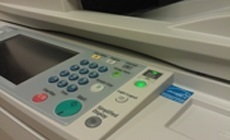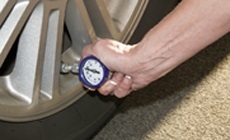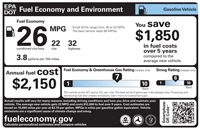|
|
| |
|
|
| |
|
|
| Things you can do about climate change |
|
| |
What You Can Do about Climate Change
This page provides more than 25 easy steps you can take at
Home, School, the Office, and On the Road to protect the
climate, reduce greenhouse gas (GHG) pollution, and save
money. Take action today. Small steps add up, if we all do
our part. |
 What
You Can Do: At Home What
You Can Do: At Home
Making a few small changes in your home and yard can reduce
greenhouse gases and save you money. Explore our list of 10
simple steps you can take to reduce greenhouse gas
emissions: |
- Change five
lights - Replace your five most frequently used
light fixtures or the lightbulbs in them with ENERGY
STAR–qualified products and you will help the
environment while saving $70 a year on energy bills.
ENERGY STAR lighting provides bright, warm light;
generates 75% less heat; uses about 75% less energy than
standard lighting; and lasts from 10 to 50 times longer.
- Look for
ENERGY STAR - When buying new products for your
home, look for EPA's ENERGY STAR label to help you make
the most energy-efficient decision. You can find the
ENERGY STAR label on more than 60 kinds of products,
including appliances, lighting, heating and cooling
equipment, electronics, and office equipment. Over their
lifetimes, products in your home that have earned the
ENERGY STAR label can reduce greenhouse gas emissions by
about 130,000 pounds and save you $11,000 on energy
bills.
- Heat and cool
smartly - Heating and cooling accounts for almost
half your energy bill—about $1,000 a year! There is a
lot you can do to drive down this cost. Simple steps
like changing air filters regularly, properly using a
programmable thermostat, and having your heating and
cooling equipment maintained annually by a licensed
contractor can save energy and increase comfort while
helping to protect the environment. Depending on where
you live, you can cut your annual energy bill by more
than $200 by replacing your old heating and cooling
equipment with ENERGY STAR–qualified equipment.
- Seal and
insulate your home - Reduce air leaks and stop
drafts by using caulk, weather stripping, and insulation
to seal your home's envelope and add more insulation to
your attic to block out heat and cold. A knowledgeable
homeowner or skilled contractor can save up to 20% on
heating and cooling costs and significantly enhance home
comfort with comprehensive sealing and insulating
measures.
- Reduce,
reuse, recycle - Reducing, reusing, and recycling
in your home helps conserve energy and reduces pollution
and greenhouse gas emissions from resource extraction,
manufacturing, and disposal. If there is a recycling
program in your community, recycle your newspapers,
beverage containers, paper, and other goods. Also,
composting your food and yard waste reduces the amount
of garbage that you send to landfills and reduces
greenhouse gas emissions. Visit EPA's Individual Waste
Reduction Model (iWARM) to learn about the energy
benefits of recycling, rather than land filling, common
waste products.
- Use water
efficiently - It takes lots of energy to pump,
treat, and heat water, so saving water reduces
greenhouse gas emissions. Saving water around the home
is simple. Three percent of the nation's energy is used
to pump and treat water, so conserving water conserves
energy that reduces greenhouse gas pollution. Reduce the
amount of waste you generate and the water you consume
whenever possible. Pursue simple water-saving actions,
such as not letting the water run while shaving or
brushing teeth, and save money while conserving water by
using products with the WaterSense label. Did you know a
leaky toilet can waste 200 gallons of water per day?
Repair all toilet and faucet leaks right away. Running
your dishwasher only with a full load can save 100
pounds of carbon dioxide and $40 per year. Be smart when
irrigating your lawn or landscape. Only water when
needed, and do it during the coolest part of the day;
early morning is best.
- Be green in
your yard - Did you know that food scraps and
yard waste make up 20-30 percent of what we throw away?
Composting your food and yard waste reduces the amount
of garbage that you send to landfills and reduces
greenhouse gas emissions. See EPA’s tips on how to
compost.
- Purchase
green power - Power your home by purchasing green
power. Green power is environmentally friendly
electricity that is generated from renewable energy
sources such as wind and the sun. There are two ways to
use green power: You can buy green power, or you can
modify your house to generate your own green power.
Buying green power is easy. It offers a number of
environmental and economic benefits over conventional
electricity, including lower greenhouse gas emissions,
and it helps increase clean energy supply. There are a
number of steps you can take to create a greener home,
including installing solar panels and researching
incentives for renewable energy in your state.
- Calculate
your household's carbon footprint - Use EPA's
Household Carbon Footprint Calculator to estimate your
household greenhouse gas emissions resulting from energy
use, transportation, and waste disposal. This tool helps
you understand where your emissions come from and
identify ways to reduce them.
- Spread the
word - Tell family and friends that energy
efficiency is good for their homes and good for the
environment because it lowers greenhouse gas emissions
and air pollution. Tell five people and together we can
help our homes help us all.
|
|
 What
You Can Do: At the Office What
You Can Do: At the Office
Business and home offices use a significant amount of
electricity for heating and cooling, lighting, and operating
equipment. Here are a number of easy ways to protect the
environment, fight climate change, and help make the air
cleaner. |
- Manage your
office equipment energy use better - Did you know
that the total electricity consumed by idle electronics
equals the annual output of 12 power plants? Save energy
and reduce greenhouse gas emissions at work by setting
your computer, monitor, and other office equipment to
power down when not in use. Activate the power
management features on your computer and monitor, unplug
laptop power cords when not in use, and turn off
equipment and lights at the end of the day. Plugging
everything into a power strip makes it easy to shut
everything down at one time.
- Look for
ENERGY STAR-qualified products for the office -
Office products that have earned the ENERGY STAR feature
special energy-efficient designs, which enable them to
use less energy while performing regular tasks. Look for
ENERGY STAR–qualified office equipment, such as
computers, copiers, and printers, in addition to more
than 60 product categories, including lighting, heating
and cooling equipment, and commercial appliances.
- Ask your
office building manager if your building has earned the
ENERGY STAR - Buildings can earn EPA's ENERGY
STAR too! ENERGY STAR-labeled buildings provide safe,
healthy, and productive environments that use about 35%
less energy than average buildings. Their efficient use
of energy also reduces the total operational cost of the
building. Let your facility's maintenance department
know about the ENERGY STAR buildings program, so they
can learn how to improve your building's performance.
- Use less
energy for your commute - Switching to public
transportation, carpooling, biking, or telecommuting can
save energy and reduce greenhouse gas emissions on your
way to and from work. Encourage your employer to offer
commuter benefits that address limited or expensive
parking, reduce traffic congestion, improve employee
recruiting and retention, and minimize the environmental
impacts associated with drive-alone commuting. If you do
drive, find out the fuel efficiency of your vehicle at
the Federal Fuel Economy website, and make more
environmentally informed choices when purchasing your
next vehicle by using EPA's Green Vehicle Guide.
- Reduce,
reuse, recycle - Reducing, reusing, and recycling
at the office helps conserve energy and reduces
pollution and greenhouse gas emissions. Reduce, reuse,
and recycle at the office by using two-sided printing
and copying; only printing what you need; buying
supplies made with recycled content; and recycling paper
products, batteries, and used printer cartridges. All of
these actions help conserve energy and reduce carbon
pollution. For old electronics (e.g., computers,
monitors, cell phones, TVs), investigate leasing
programs, manufacturer and retailer take-back programs,
and municipal programs and events to ensure reuse and
recycling. You can also donate used equipment to schools
or other organizations and take advantage of any
available tax incentives for computer donations.
- Use green
power - Emissions from electricity generated from
fossil fuels can be one of the most significant
environmental impacts associated with your
organization's operations. Green power is electricity
that is generated from renewable energy sources such as
wind, sun, geothermal, and biomass. Purchasing green
power is an easy, effective way for your organization to
reduce its carbon footprint and environmental impact.
Visit EPA's Green Power Partnership for information on
how to purchase green power.
- Encourage
your organization to develop a greenhouse gas inventory
- Developing a greenhouse gas inventory is a critical
first step toward measuring and managing your
organization’s climate change impact. An inventory is a
list of emission sources and the associated emissions
quantified using standardized methods. Many
organizations are taking this step and by doing so find
that most of their emissions come from building heating
and cooling, fleet vehicles, electricity use, and
employee travel. EPA’s Center for Corporate Climate
Leadership is a resource center to help all
organizations identify and achieve
cost-effective greenhouse gas emission reductions.
|
|
 What
You Can Do: On the Road What
You Can Do: On the Road
Driving your vehicle releases greenhouse gases into the
atmosphere and contributes to climate change—but you can
take simple, easy steps to cut your emissions, reduce our
nation's dependence on oil, and save money. |
 Fuel
economy and environment label Fuel
economy and environment label
The fuel economy and environment label that you’ll see on
all new vehicles has been redesigned and updated for even
easier comparison shopping. These new window stickers
provide fuel economy and environmental ratings for all new
vehicles, including advanced technology vehicles like
electric cars and plug-in hybrids. And while at the
showroom, you can scan the QR Code® on each vehicle’s label
to be connected to additional information online, including
personalized cost and energy-use estimates. |
- Buy smart:
Purchase a fuel-efficient, low-greenhouse gas vehicle
- When shopping for a new or used vehicle (or even
renting a vehicle), choose the cleanest, most
fuel-efficient vehicle that meets your needs. With a
wide range of clean, fuel-efficient vehicles available
today, it’s easier than ever to go green—for the
environment and for your wallet.
- Drive smart
- To improve your fuel economy and reduce greenhouse gas
emissions, go easy on the brakes and gas pedal, avoid
hard accelerations, reduce your time spent idling (no
more than 30 seconds), and unload unnecessary items in
your trunk to reduce weight. If you have a removable
roof rack and you are not using it, take it off to
improve your fuel economy. Use cruise control if you
have it, and for vehicles with selectable four-wheel
drive, consider operating in two-wheel drive mode when
road conditions make it safe to do so.
- Remember
maintenance - Get regular tune-ups, follow the
manufacturer’s maintenance schedule (which can be found
in your owner’s manual), and use the recommended grade
of motor oil. A well-maintained car is more
fuel-efficient, produces fewer greenhouse gas emissions,
is more reliable, and is safer.
- And don’t
forget your tires - Check your tire pressure
regularly. Under-inflation increases tire wear, reduces
your fuel economy, and leads to higher greenhouse gas
and other air pollutant emissions. If you don’t know the
correct tire pressure for your vehicle, you can find it
listed on the door to your vehicle’s glove compartment,
or on the driver's-side door pillar. And when it’s time
for new tires, consider purchasing tires with “low
rolling resistance,” an energy-saving feature.
- Give your car
a break - Use public transportation, carpool, or
walk or bike whenever possible to avoid using your
car. Leaving your car at home just two days a week can
reduce your greenhouse gas emissions by an average of 2
tons per year.
- Also consider
telecommuting (working from home via phone or the
Internet) - This can reduce the stress of
commuting, reduce harmful emissions, and save you
money. And when driving, try combining your errands and
activities into one trip.
- Use renewable
fuels - Give E85 and biodiesel a try. Both are
renewable fuels (made from renewable sources such as
corn) that can reduce greenhouse gas emissions from your
vehicle. E85 is a fuel blend containing 85% ethanol and
15% gasoline that can be used in certain vehicles called
Flex Fuel Vehicles (FFVs). FFVs are designed to be
fueled with either E85 or traditional gasoline. There
are millions of FFVs on the road today—to find out if
you own one, check the inside of your car's fuel door
for an identification sticker, or consult your owner’s
manual. If you own a diesel vehicle, consider filling up
with a biodiesel blend such as B5, which is a diesel
fuel blend containing 5% biodiesel.
|
|
 What
You Can Do: At School What
You Can Do: At School
Students, educators, and school administrators can all play
a key role in reducing greenhouse gas emissions.
Here is a directory of resources to help you: |
Students
Middle school students: Explore
climate science
Explore A Student's Guide to Global Climate Change to learn
more about the science and impacts of climate change. The
site also provides videos, animations, and interactive
expeditions where students can explore and learn how climate
change will affect places around the world. The site helps
students, their parents, and their teachers learn about
solutions and the actions they can take to reduce greenhouse
emissions.
High school students: Track your
school's climate impact
Use Portfolio Manager to compare the energy use of your
school with other schools nationwide, and earn the ENERGY
STAR for your school if it qualifies as a top performer.
College students: Get involved at
your college or university
College students can play an important role in reducing
greenhouse emissions at their colleges or universities by
reducing their emissions from energy they use in dorm rooms.
Students can also work with school administrators to develop
an inventory Exit, increase energy efficiency on campus, and
reduce their school's greenhouse gas emissions by
using green power. |
|
|
Educators
Teach students about climate change and ecosystems
Use the teacher resources on EPA's Students Guide to
Global Climate Change.
Engage middle school students in
estimating emissions
Enhance critical-thinking skills by introducing the
Greenhouse Gas Emissions Calculator to middle school
students. The online calculator lists 16 easy actions
students can take to save energy, and calculates the
reductions in carbon dioxide emissions. The calculator also
features links to more information explaining the links
between everyday actions and carbon pollution, and
providing additional tips for kids who want to do more.
Learn from other educators
Investigate what other schools and organizations are doing
to educate their audiences on climate change by viewing
Additional Web Resources, a database offering links to
resources such as lesson plans, videos, books, and toolkits.
Administrators
Save money and the environment
The least efficient schools use three times more energy than
the best energy performers. By partnering with the highly
successful ENERGY STAR for K-12 School Districts and using
Portfolio Manager to track and rate the energy performance
of their portfolio of school buildings, school districts can
serve as environmental leaders in their community, become
energy-efficient, reduce greenhouse gas emissions, and save
money! If you're considering a new building, EPA's voluntary
School Siting Guidelines can provide tips for reducing
climate and health impacts.
Estimate your emissions and take the
challenge
School administrators can also work to reduce their school's
greenhouse gas emissions by developing an inventory Exit of
their school's emissions or by taking the College &
University Green Power Challenge.
Reduce, reuse, recycle
Recycle school or classroom paper, newspapers, beverage
containers, electronic equipment, and batteries. Reducing,
reusing, and recycling at school and in the classroom helps
conserve energy and reduces pollution and greenhouse gases
from resource extraction, manufacturing, and disposal. You
can reduce, reuse, and recycle at school or in the classroom
by using two-sided printing and copying, buying supplies
made with recycled content, and recycling used printer
cartridges. For your old electronics, donate used equipment
to other organizations, or investigate leasing programs to
ensure that used equipment is reused and recycled.
Did You Know?
Of the $1,900 per year an average household spends on
utility bills, half pays for heating and cooling. Depending
on where you live, replacing your old heating and cooling
equipment with ENERGY STAR–qualified equipment and properly
sealing your ducts can cut your energy bill by about $180
(nearly 10%).
Did You Know?
Current national recycling efforts reduce greenhouse gas
emissions by 49.9 million metric tons of carbon equivalent,
which is equivalent to the annual emissions from 39.6
million passenger cars. |
|
|
|
|
|
|
|
|
|
|
|
|
Additional Climate Change Information |
Climate Change and Carbon Dioxide
(Beginner - Listening,
reading)
A video lesson to
help with your understanding of climate change
and carbon dioxide.
The English is
spoken at 75% of normal speed.
Great English listening and reading practice. |
Carbon Dioxide and Climate Change
(Beginner - Listening,
reading)
A video lesson to
help with your understanding of carbon dioxide
and climate change.
The English is
spoken at 75% of normal speed.
Great English listening and reading practice. |
Environmental Group Warns Earth's Health at Risk
(Beginner - Listening,
reading)
A video lesson to
help with your understanding of climate change.
The English is
spoken at 75% of normal speed.
Great English listening and reading practice.
A report by the World Wildlife Fund looked at thousands of animal populations
and found they have dropped significantly in 40 years. |
Sea Levels Rising at Fastest Rate in 3,000 years
(Beginner - Listening,
reading)
A video lesson to
help with your understanding of climate change.
The English is
spoken at 75% of normal speed.
Great English listening and reading practice.
A group of scientists say sea levels are rising at record rates. Another group
found that January temperatures in the Arctic reached a record high. |
Capturing CO2 Gas Is Not Easy
(Beginner - Listening,
reading)
A video lesson to
help with your understanding of climate change.
The English is
spoken at 75% of normal speed.
Great English listening and reading practice.
Most scientists agree that carbon-dioxide gas is partly to blame for climate
change: rising global temperatures. But capturing the CO2 gas released by power
stations is costly and difficult. |
Growth, Climate Change Threaten African Plants and
Animals
(Beginner - Listening,
reading)
A video lesson to
help with your understanding of climate change.
The English is
spoken at 75% of normal speed.
Great English listening and reading practice.
Researchers believe Africa may lose as much as 30 percent of its animal and
plant species by the end of this century. |
|
|
|
|
Search Fun Easy English |
|
|
|
|
|
|
|
|
|
|
|
|
|
|
|
About
Contact
Copyright
Resources
Site Map |